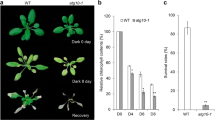Abstract
The polypeptide encoded by the partial fragment of cDNA of phenylalanine ammonia-lyase (PAL; EC 4.3.1.5), PALcDNAl (Osakabe et al., 1995, Plant Sci. 105: 217–226), isolated from Populus kitakamiensis (P. sieboldii x P. grandidentata), was expressed in Escherichia coli cells. The polypeptide was purified and an antiserum raised against it. The antiserum recognized a protein of 77 kDa on nitrocellulose blots after sodium dodecyl sulfate-poly-acrylamide gel electrophoresis of total protein and the partially purified PAL protein from P. kitakamiensis. Moreover,the antiserum recognized a protein on the blot after non-denaturing polyacrylamide gel electrophoresis of P. kitakamiensis proteins and this protein had PAL activity. Furthermore, the antibody inhibited PAL activity of extracts from stem tissues. These results showed that the antiserum against the partial PAL peptide recognized only the PAL subunits in extracts of P. kitakamiensis. Immunolocalization studies of P. kitakamiensis tissues revealed that the PAL protein was specifically localized in the xylem and the phloem fibers and no immunogold signal was found in the epidermis, the cortex, the pith, or the cambium of either stems or leaves.
Similar content being viewed by others
Abbreviations
- IgG:
-
immunoglobulin G
- IPTG:
-
isopropylthio-β-d-galactoside
- PAL:
-
phenylalanine ammonia-lyase
References
Bevan M, Schufflebottom D, Edwards K, Jefferson R, Schuch W (1989) Tissueand cell-specific activity of a phenylalanine ammonia-lyase promoter in transgenic plants. EMBO J 8: 1899–1906
Bolwell GP, Rodgers MW (1991) L-phenylalanine ammonia-lyase from french bean (Phaseolus vulgaris L.) Characterization and differential expression of antigenic multiple Mr forms. Biochem J 279: 231–236
Campbell MM, Ellis BE (1992) Fungal elicitor-mediated responses in pine cell cultures. Plant Physiol 98: 62–70
Feuillet C, Lauvergeat V, Deswarte C, Pilate G, Boudet A, Grima-Pettenati J (1995) Tissue- and cell-specific expression of a cinnamyl alcohol dehydrogenase promoter in transgenic poplar plants. Plant Mol Biol 27: 651–667
Hahlbrock K, Scheel D (1989) Physiology and molecular biology of phenylpropanoid metabolism. Annu Rev Plant Physiol Plant Mol Biol 40: 347–369
Hames BD, Rickwood D (1990) Gel. In: Electrophoresis of proteins. A practical approach (2nd edn). Oxford University Press, New York
Haufte KD, Lee SP, Subramaniam R, Douglas CJ (1993) Combinatorial interactions between positive and negative cis-acting elements control spatial patterns of 4CL-1 expression in transgenic tobacco. Plant J 4: 235–253
Havir EA, Hanson KR (1973) L-phenylalanine ammonia-lyase (maize and potato). Evidence that the enzyme is composed of four subunits. Biochemistry 12: 1583–1591
Higuchi T (1985) Biosynthesis of lignin. In: Higuchi T (ed) Biosynthesis and biodegradation of wood components. Academic Press, New York, pp 141–160
Jones DH (1984) Phenylalanine ammonia-lyase: regulation of its induction, and its role in plant development. Phytochemistry 23:1349–1359
Koukol J, Conn EE (1961) The metabolism of aromatic compounds in higher plants. J Biol Chem 236: 2692–2698
Kuhn DN, Chappell J, Boudet A, Hahibrock K (1984) Induction of phenylalanine ammonia-lyase and 4-coumarate:CoA ligase mRNAs in cultured plant cells by UV light or fungal elicitors. Proc Natl Acad Sci USA 81: 1102–1106
Leyva A, Liang X, Pintor-Toro JA, Dixon RA, Lamb CJ (1992) ciselement combinations determine phenylalanine ammonia-lyase gene tissue-specific expression patterns. Plant Cell 4: 263–271
Liang X, Dron M, Cramer C, Dixon RA, Lamb CJ (1989a) Differential regulation of phenylalanine ammonia-lyase genes during development and by environmental cues. J Biol Chem 264:14486–14492
Liang X, Dron M, Schmid J, Dixon RA, Lamb CJ (1989b) Developmental and environmental regulation of a phenylalanine ammonia-lyase-β-glucuronidase gene fusion in transgenic tobacco plants. Proc Natl Acad Sci USA 86: 9284–9288
Lois R, Dietrich A, Hahlbrock K, Schultz W (1989) A phenylalanine ammonia-lyase gene from parsley: structure, regulation, and identification of cis-acting elements. EMBO J 8: 1641–1648
Lois R, Hahlbrock K (1992) Differential wound activation of members of the phenylalanine ammonia-lyase and 4-coumarate: CoA ligase gene families in various organs of parsley plants. Z Naturforsch 47c: 90–94
Murphy JB, Stutte CA (1978) Analysis for substituted benzoic and cinnamic acids using high-pressure liquid chromatography. Anal Biochem 86: 220–228
Osakabe Y, Ohtsubo Y, Kawai S, Katayama Y, Morohoshi N (1995a) Structure and tissue-specific expression of genes for phenylalanine ammonia-lyase from a hybrid aspen, Populus kitakamiensis. Plant Sci 105: 217–226
Osakabe Y, Osakabe K, Kawai S, Katayama Y, Morohoshi N (1995b) Characterization of the structure and determination of mRNA levels of phenylalanine ammonia-lyase gene family from Populus kitakamiensis. Plant Mol Biol 28: 1133–1141
Rubery PH, Northcote DH (1968) Site of phenylalanine ammonia-lyase activity and the synthesis of lignin during xylem differentiation. Nature 219: 1230–1232
Smith CG, Rodgers MW, Zimmerlin A, Ferdinande D, Bolwell GP (1994) Tissue and subcellular immunolocalisation of enzymes of lignin synthesis in differentiating and wounded hypocotyl tissue of French bean (Phaseolus vulgaris L). Planta 192: 155–164
Subramaniam R, Reinold S, Molitor EK, Douglas CJ (1993) Structure, Inheritance, and expression of hybrid poplar (Populus trichocarpa x Populus deltoides) phenylalanine ammonia-lyase genes. Plant Physiol 102: 71–83
Walter MH (1989) The induction of phenylpropanoid biosynthetic enzymes by ultraviolet light or fungal elicitor in cultured parsley cells is overriden by a heat-shock treatment. Planta 177: 1–8
Zimmermann A, Hahlbrock K (1975) Light-induced changes in enzyme activities in parsley cell suspension cultures. Arch Biochem Biophys 166: 54–62
Author information
Authors and Affiliations
Additional information
The authors thank Dr. Kunio Hata of Nippon Paper Industries Co., Ltd. (Japan) for supplying P. kitakamiensis. This work was supported in part by a grant-in-aid for Scientific Research from the Ministry of Education, Science and Culture of Japan (No. 07406008).
Rights and permissions
About this article
Cite this article
Osakabe, Y., Nanto, K., Kitamura, H. et al. Immunocytochemical localization of phenylalanine ammonia-lyase in tissues of Populus kitakamiensis . Planta 200, 13–19 (1996). https://doi.org/10.1007/BF00196643
Received:
Accepted:
Issue Date:
DOI: https://doi.org/10.1007/BF00196643




